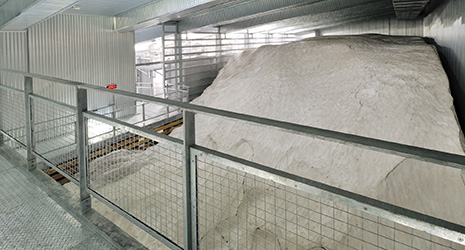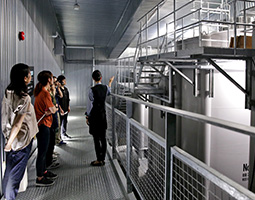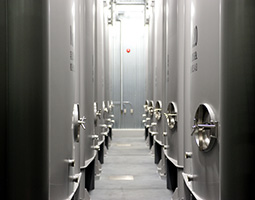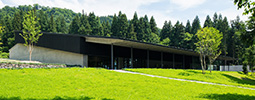INDEX
- English
- 日本語

Inside the yukimuro (snow cellar), where up to 1,000 tons of snow are stored - English
- 日本語

Uonuma no Sato (Uonuma Village) is situated in one of the heaviest snowfall areas in Japan making it well suited to the production of sake, which requires clean air and water

Rich and mellow “snow-aged” sake 
The chill from the snow alone keeps the room temperature at a constant 3 to 4 degrees Celsius 
The facility’s tanks hold 360,000 liters of sake 
Hakkaisan Yukimuro was designed in 2013 and has won numerous architecture awards in Japan
January 2022
Snow Aged Sake

In the “snow country” of Niigata Prefecture, fresh food produce used to be stored all year round in natural refrigerators called “yukimuro” (literally, snow cellars). In the same prefecture today, a brewing company is drawing on the wisdom of snow refrigeration to produce “uniquely mellow and rich” sake.

Minamiuonuma City in southeastern Niigata Prefecture is known as one of the heaviest snowfall areas in Japan. Before electric refrigerators came into widespread use, natural refrigerators known as “yukimuro,” snow cellars made from snow accumulated during the winter and insulated with straw and other materials, were used all year round to preserve foods such as vegetables and fish.
Hakkaisan Brewery Co., Ltd., which produces Japanese sake in the foothills of Mt. Hakkai in Uonuma, built the Hakkaisan Yukimuro in 2013, harnessing that wisdom. The facility is a natural convection* snow cellar with three layers of insulation, a storage chamber that can store up to 1,000 tons of snow, and a snow-cooled storehouse. It has a constant internal temperature of between 3 and 4 degrees Celsius. The facility’s tanks hold 360,000 liters of maturing sake, equivalent to 200,000 1.8-liter bottles. In addition, the cool air created by letting cool breezes pass through the yukimuro is sent to the refrigerators of stores that sell sake and other fermented foods as “snow cooling” to replace part of the electricity needed. The yukimuro building has also garnered numerous awards for its simple yet modern architecture that blends pleasingly with its natural surrounds.

Hamasaki Kozue, public relations coordinator for Hakkaisan Brewery, explains about the facility. “The construction of the Hakkaisan Yukimuro was prompted by the Great East Japan Earthquake in March 2011. As we began to consider introducing natural energy rather than relying on conventional sources, we looked at the ancient yukimuro tradition in the Uonuma region. In our daily lives, snow is often seen as a nuisance, causing disruption to traffic and requiring us to clear it from our roofs. We decided to reframe snow as a ‘resource’ and proactively harness the benefits of our snow country location.”
Sake stored in the Hakkaisan Yukimuro for three years is said to acquire a mellow flavor. Since 2016, the company has been marketing this “snow-aged” Junmai Daiginjo** sake.

Says Hamasaki, “With thermal tanks (tanks that can be temperature controlled individually) that are widely used to store sake, the faint hum of the machines is transmitted to the sake inside the tanks. In contrast, the yukimuro has no noise or vibration from machines, so is extremely quiet. This, together with the stable low temperature and high humidity environment, brings about changes in the sake to produce a uniquely mellow and rich taste.”

The Uonuma region is known as a place where one of Japan’s most delicious varieties of rice, Koshihikari, is grown. Besides sake, Hakkaisan Yukimuro stores produce such as locally-grown Koshihikari rice and vegetables, which are sold in the on-site shop. The plump rice and wonderfully sweet root vegetables are popular for their flavor.
Hakkaisan Yukimuro offers tours daily. Hamasaki says participants are amazed to see large volumes of snow at the facility all year round.
“Even at the height of summer when the temperature exceeds 30 degrees Celsius, inside the facility it’s as cool as a refrigerator. You get a real sense of the power of snow as a clean energy source.”

Hakkaisan Yukimuro stores sake and vegetables using natural energy rather than electricity, and in doing so also stores the wisdom inherited from the people of the snow country, passing it on to the next generation.
* A method of maintaining temperature using natural airflow caused by changes in temperature and pressure differences that occur in the air.
** A daiginjo sake is sake produced from rice grains that have been polished to a minimum of 50% their original size.

